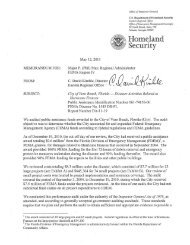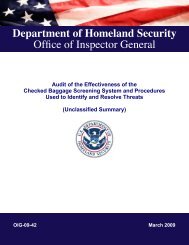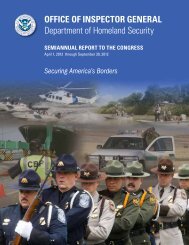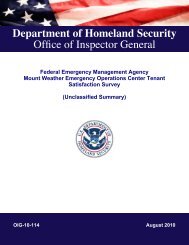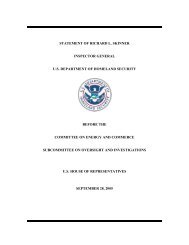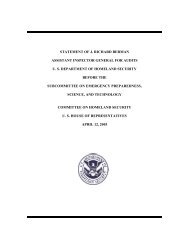Report on US Citizenship and Immigration Services - Office of ...
Report on US Citizenship and Immigration Services - Office of ...
Report on US Citizenship and Immigration Services - Office of ...
You also want an ePaper? Increase the reach of your titles
YUMPU automatically turns print PDFs into web optimized ePapers that Google loves.
Department <strong>of</strong> Homel<strong>and</strong> Security<br />
<strong>Office</strong> <strong>of</strong> Inspector General<br />
Independent Auditors' <str<strong>on</strong>g>Report</str<strong>on</strong>g> <strong>on</strong> <br />
U.S. <strong>Citizenship</strong> <strong>and</strong> Immigrati<strong>on</strong> <strong>Services</strong>' <br />
FY 2009 C<strong>on</strong>solidated Balance Sheet <br />
OIG-10-59 February 2010
<strong>Office</strong> <strong>of</strong> Inspector General<br />
U.S. Department <strong>of</strong> Homel<strong>and</strong> Security<br />
Washingt<strong>on</strong>, DC 20528<br />
February 25, 2010<br />
Preface<br />
The Department <strong>of</strong> Homel<strong>and</strong> Security (DHS) <strong>Office</strong> <strong>of</strong> Inspector General (OIG) was<br />
established by the Homel<strong>and</strong> Security Act <strong>of</strong> 2002 (Public Law 107-296) by amendment<br />
to the Inspector General Act <strong>of</strong> 1978. This is <strong>on</strong>e <strong>of</strong> a series <strong>of</strong> audit, inspecti<strong>on</strong>, <strong>and</strong><br />
special reports prepared as part <strong>of</strong> our oversight resp<strong>on</strong>sibilities to promote ec<strong>on</strong>omy,<br />
efficiency, <strong>and</strong> effectiveness within the department.<br />
The attached report presents the results <strong>of</strong> the U.S. <strong>Citizenship</strong> <strong>and</strong> Immigrati<strong>on</strong> <strong>Services</strong>’<br />
c<strong>on</strong>solidated balance sheet audit for fiscal year (FY) 2009. We c<strong>on</strong>tracted with the<br />
independent public accounting firm KPMG LLP (KPMG) to perform the audit. The<br />
c<strong>on</strong>tract required that KPMG perform its audit according to generally accepted<br />
government auditing st<strong>and</strong>ards <strong>and</strong> guidance from the <strong>Office</strong> <strong>of</strong> Management <strong>and</strong> Budget<br />
<strong>and</strong> the Government Accountability <strong>Office</strong>. KPMG c<strong>on</strong>cluded that <strong>US</strong>CIS’ c<strong>on</strong>solidated<br />
balance sheet as <strong>of</strong> September 30, 2009, is presented fairly, in all material respects, in<br />
c<strong>on</strong>formity with U.S. generally accepted accounting principles. The FY 2009 auditors’<br />
report discusses two material weaknesses, <strong>and</strong> two significant deficiencies in internal<br />
c<strong>on</strong>trol. KPMG is resp<strong>on</strong>sible for the attached auditors’ report, <strong>and</strong> the c<strong>on</strong>clusi<strong>on</strong>s<br />
expressed in the report. We do not express opini<strong>on</strong>s <strong>on</strong> <strong>US</strong>CIS’ c<strong>on</strong>solidated balance<br />
sheet or provide c<strong>on</strong>clusi<strong>on</strong>s <strong>on</strong> compliance with laws <strong>and</strong> regulati<strong>on</strong>s.<br />
The recommendati<strong>on</strong>s herein have been discussed in draft with those resp<strong>on</strong>sible for<br />
implementati<strong>on</strong>. We trust this report will result in more effective, efficient, <strong>and</strong><br />
ec<strong>on</strong>omical operati<strong>on</strong>s. We express our appreciati<strong>on</strong> to all <strong>of</strong> those who c<strong>on</strong>tributed to<br />
the preparati<strong>on</strong> <strong>of</strong> this report.<br />
Richard L. Skinner <br />
Inspector General
KPMG LLP<br />
2001 M Street, NW<br />
Washingt<strong>on</strong>, DC 20036<br />
Independent Auditors’ <str<strong>on</strong>g>Report</str<strong>on</strong>g><br />
Director <strong>of</strong> the U.S. Department <strong>of</strong> Homel<strong>and</strong> Security<br />
U.S. <strong>Citizenship</strong> <strong>and</strong> Immigrati<strong>on</strong> <strong>Services</strong>, <strong>and</strong> Inspector General,<br />
U.S. Department <strong>of</strong> Homel<strong>and</strong> Security:<br />
We have audited the accompanying c<strong>on</strong>solidated balance sheet <strong>of</strong> the U.S. Department <strong>of</strong> Homel<strong>and</strong><br />
Security (DHS) U.S. <strong>Citizenship</strong> <strong>and</strong> Immigrati<strong>on</strong> <strong>Services</strong> (<strong>US</strong>CIS) as <strong>of</strong> September 30, 2009. The<br />
objective <strong>of</strong> our audit was to express an opini<strong>on</strong> <strong>on</strong> the fair presentati<strong>on</strong> <strong>of</strong> this c<strong>on</strong>solidated balance sheet.<br />
In c<strong>on</strong>necti<strong>on</strong> with our fiscal year 2009 audit, we also c<strong>on</strong>sidered <strong>US</strong>CIS’s internal c<strong>on</strong>trols over financial<br />
reporting, <strong>and</strong> tested <strong>US</strong>CIS’s compliance with certain provisi<strong>on</strong>s <strong>of</strong> applicable laws, regulati<strong>on</strong>s,<br />
c<strong>on</strong>tracts, <strong>and</strong> grant agreements that could have a direct <strong>and</strong> material effect <strong>on</strong> the c<strong>on</strong>solidated balance<br />
sheet.<br />
Summary<br />
As stated in our opini<strong>on</strong> <strong>on</strong> the c<strong>on</strong>solidated balance sheet, the accompanying c<strong>on</strong>solidated balance sheet as<br />
<strong>of</strong> September 30, 2009, is presented fairly, in all material respects, in c<strong>on</strong>formity with U.S. generally<br />
accepted accounting principles.<br />
Our c<strong>on</strong>siderati<strong>on</strong> <strong>of</strong> internal c<strong>on</strong>trol over financial reporting resulted in the following c<strong>on</strong>diti<strong>on</strong>s being<br />
identified as significant deficiencies:<br />
A. Informati<strong>on</strong> Technology General <strong>and</strong> Applicati<strong>on</strong> C<strong>on</strong>trols<br />
B. General Property, Plant, <strong>and</strong> Equipment<br />
C. Deferred Revenue<br />
D. Accounts Payable<br />
We c<strong>on</strong>sider significant deficiencies A <strong>and</strong> B, above, to be material weaknesses.<br />
The results <strong>of</strong> our tests <strong>of</strong> compliance with certain provisi<strong>on</strong>s <strong>of</strong> laws, regulati<strong>on</strong>s, c<strong>on</strong>tracts, <strong>and</strong> grant<br />
agreements disclosed no instances <strong>of</strong> n<strong>on</strong>compliance or other matters that are required to be reported under<br />
Government Auditing St<strong>and</strong>ards, issued by the Comptroller General <strong>of</strong> the United States, <strong>and</strong> <strong>Office</strong> <strong>of</strong><br />
Management <strong>and</strong> Budget (OMB) Bulletin No. 07-04, Audit Requirements for Federal Financial<br />
Statements.<br />
The following secti<strong>on</strong>s discuss our opini<strong>on</strong> <strong>on</strong> <strong>US</strong>CIS’s c<strong>on</strong>solidated balance sheet; our c<strong>on</strong>siderati<strong>on</strong> <strong>of</strong><br />
<strong>US</strong>CIS’s internal c<strong>on</strong>trols over financial reporting; our tests <strong>of</strong> the <strong>US</strong>CIS’s compliance with certain<br />
provisi<strong>on</strong>s <strong>of</strong> applicable laws, regulati<strong>on</strong>s, c<strong>on</strong>tracts, <strong>and</strong> grant agreements; <strong>and</strong> management’s <strong>and</strong> our<br />
resp<strong>on</strong>sibilities.<br />
Opini<strong>on</strong> <strong>on</strong> the C<strong>on</strong>solidated Balance Sheet<br />
We have audited the accompanying c<strong>on</strong>solidated balance sheet <strong>of</strong> the U.S. <strong>Citizenship</strong> <strong>and</strong> Immigrati<strong>on</strong><br />
<strong>Services</strong> as <strong>of</strong> September 30, 2009.<br />
KPMG LLP, a U.S. limited liability partnership, is the U.S.<br />
member firm <strong>of</strong> KPMG Internati<strong>on</strong>al, a Swiss cooperative.
In our opini<strong>on</strong>, the c<strong>on</strong>solidated balance sheet referred to above presents fairly, in all material respects, the<br />
financial positi<strong>on</strong> <strong>of</strong> <strong>US</strong>CIS as <strong>of</strong> September 30, 2009, in c<strong>on</strong>formity with U.S. generally accepted<br />
accounting principles.<br />
The informati<strong>on</strong> in the Overview secti<strong>on</strong> is not a required part <strong>of</strong> the c<strong>on</strong>solidated balance sheet, but is<br />
supplementary informati<strong>on</strong> required by U.S. generally accepted accounting principles. We have applied<br />
certain limited procedures, which c<strong>on</strong>sisted principally <strong>of</strong> inquiries <strong>of</strong> management regarding the methods<br />
<strong>of</strong> measurement <strong>and</strong> presentati<strong>on</strong> <strong>of</strong> this informati<strong>on</strong>. However, we did not audit this informati<strong>on</strong> <strong>and</strong>,<br />
accordingly, we express no opini<strong>on</strong> <strong>on</strong> it.<br />
Internal C<strong>on</strong>trol over Financial <str<strong>on</strong>g>Report</str<strong>on</strong>g>ing<br />
Our c<strong>on</strong>siderati<strong>on</strong> <strong>of</strong> the internal c<strong>on</strong>trol over financial reporting was for the limited purpose described in<br />
the Resp<strong>on</strong>sibilities secti<strong>on</strong> <strong>of</strong> this report <strong>and</strong> would not necessarily identify all deficiencies in the internal<br />
c<strong>on</strong>trol over financial reporting that might be significant deficiencies or material weaknesses.<br />
A c<strong>on</strong>trol deficiency exists when the design or operati<strong>on</strong> <strong>of</strong> a c<strong>on</strong>trol does not allow management or<br />
employees, in the normal course <strong>of</strong> performing their assigned functi<strong>on</strong>s, to prevent or detect misstatements<br />
<strong>on</strong> a timely basis. A significant deficiency is a c<strong>on</strong>trol deficiency, or combinati<strong>on</strong> <strong>of</strong> c<strong>on</strong>trol deficiencies,<br />
that adversely affects <strong>US</strong>CIS’s ability to initiate, authorize, record, process, or report financial data reliably<br />
in accordance with U.S. generally accepted accounting principles such that there is more than a remote<br />
likelihood that a misstatement <strong>of</strong> <strong>US</strong>CIS’s c<strong>on</strong>solidated balance sheet that is more than inc<strong>on</strong>sequential<br />
will not be prevented or detected by <strong>US</strong>CIS’s internal c<strong>on</strong>trol. A material weakness is a significant<br />
deficiency, or combinati<strong>on</strong> <strong>of</strong> significant deficiencies, that results in more than a remote likelihood that a<br />
material misstatement <strong>of</strong> the c<strong>on</strong>solidated balance sheet will not be prevented or detected by <strong>US</strong>CIS’s<br />
internal c<strong>on</strong>trol.<br />
In our fiscal year 2009 audit, we c<strong>on</strong>sider the deficiencies, described in Exhibits I <strong>and</strong> II, to be significant<br />
deficiencies in internal c<strong>on</strong>trol over financial reporting. However, <strong>of</strong> the significant deficiencies described<br />
in Exhibits I <strong>and</strong> II, we believe that the significant deficiencies presented in Exhibit I are material<br />
weaknesses.<br />
Compliance <strong>and</strong> Other Matters<br />
The results <strong>of</strong> our tests <strong>of</strong> compliance as described in the Resp<strong>on</strong>sibilities secti<strong>on</strong> <strong>of</strong> this report, disclosed<br />
no instances <strong>of</strong> n<strong>on</strong>compliance or other matters that are required to be reported herein under Government<br />
Auditing St<strong>and</strong>ards or OMB Bulletin No. 07-04.<br />
Resp<strong>on</strong>sibilities<br />
Management’s Resp<strong>on</strong>sibilities. Management is resp<strong>on</strong>sible for the c<strong>on</strong>solidated balance sheet;<br />
establishing <strong>and</strong> maintaining effective internal c<strong>on</strong>trol; <strong>and</strong> complying with laws, regulati<strong>on</strong>s, c<strong>on</strong>tracts,<br />
<strong>and</strong> grant agreements applicable to <strong>US</strong>CIS.<br />
Auditors’ Resp<strong>on</strong>sibilities. Our resp<strong>on</strong>sibility is to express an opini<strong>on</strong> <strong>on</strong> <strong>US</strong>CIS’s c<strong>on</strong>solidated balance<br />
sheet as <strong>of</strong> September 30, 2009, based <strong>on</strong> our audit. We c<strong>on</strong>ducted our audit in accordance with auditing<br />
st<strong>and</strong>ards generally accepted in the United States <strong>of</strong> America; the st<strong>and</strong>ards applicable to financial audits<br />
c<strong>on</strong>tained in Government Auditing St<strong>and</strong>ards, issued by the Comptroller General <strong>of</strong> the United States; <strong>and</strong><br />
OMB Bulletin No. 07-04. Those st<strong>and</strong>ards <strong>and</strong> OMB Bulletin No. 07-04 require that we plan <strong>and</strong> perform<br />
the audit to obtain reas<strong>on</strong>able assurance about whether the c<strong>on</strong>solidated balance sheet is free <strong>of</strong> material<br />
misstatement. An audit includes c<strong>on</strong>siderati<strong>on</strong> <strong>of</strong> internal c<strong>on</strong>trol over financial reporting as a basis for<br />
designing audit procedures that are appropriate in the circumstances, but not for the purpose <strong>of</strong> expressing<br />
an opini<strong>on</strong> <strong>on</strong> the effectiveness <strong>of</strong> <strong>US</strong>CIS’s internal c<strong>on</strong>trol over financial reporting. Accordingly, we<br />
express no such opini<strong>on</strong>.<br />
2
An audit also includes:<br />
<br />
<br />
<br />
Examining, <strong>on</strong> a test basis, evidence supporting the amounts <strong>and</strong> disclosures in the notes to the<br />
c<strong>on</strong>solidated balance sheet;<br />
Assessing the accounting principles used <strong>and</strong> significant estimates made by management; <strong>and</strong><br />
Evaluating the overall c<strong>on</strong>solidated balance sheet presentati<strong>on</strong>.<br />
We believe that our audit provides a reas<strong>on</strong>able basis for our opini<strong>on</strong>.<br />
In planning <strong>and</strong> performing our audit <strong>of</strong> <strong>US</strong>CIS’s c<strong>on</strong>solidated balance sheet as <strong>of</strong> September 30, 2009, we<br />
c<strong>on</strong>sidered <strong>US</strong>CIS’s internal c<strong>on</strong>trol over financial reporting by obtaining an underst<strong>and</strong>ing <strong>of</strong> <strong>US</strong>CIS’s<br />
internal c<strong>on</strong>trol, determining whether internal c<strong>on</strong>trols had been placed in operati<strong>on</strong>, assessing c<strong>on</strong>trol risk,<br />
<strong>and</strong> performing tests <strong>of</strong> c<strong>on</strong>trols as a basis for designing our auditing procedures for the purpose <strong>of</strong><br />
expressing our opini<strong>on</strong> <strong>on</strong> the c<strong>on</strong>solidated balance sheet. We did not test all internal c<strong>on</strong>trols relevant to<br />
operating objectives as broadly defined by the Federal Managers’ Financial Integrity Act <strong>of</strong> 1982. The<br />
objective <strong>of</strong> our audit was not to express an opini<strong>on</strong> <strong>on</strong> the effectiveness <strong>of</strong> <strong>US</strong>CIS’s internal c<strong>on</strong>trol over<br />
financial reporting. Accordingly, we do not express an opini<strong>on</strong> <strong>on</strong> the effectiveness <strong>of</strong> <strong>US</strong>CIS’s internal<br />
c<strong>on</strong>trol over financial reporting.<br />
As part <strong>of</strong> obtaining reas<strong>on</strong>able assurance about whether <strong>US</strong>CIS’s c<strong>on</strong>solidated balance sheet as <strong>of</strong><br />
September 30, 2009 is free <strong>of</strong> material misstatement, we performed tests <strong>of</strong> <strong>US</strong>CIS’s compliance with<br />
certain provisi<strong>on</strong>s <strong>of</strong> laws, regulati<strong>on</strong>s, c<strong>on</strong>tracts, <strong>and</strong> grant agreements, n<strong>on</strong>compliance with which could<br />
have a direct <strong>and</strong> material effect <strong>on</strong> the determinati<strong>on</strong> <strong>of</strong> the c<strong>on</strong>solidated balance sheet amounts, <strong>and</strong><br />
certain provisi<strong>on</strong>s <strong>of</strong> other laws <strong>and</strong> regulati<strong>on</strong>s specified in OMB Bulletin No. 07-04. We limited our tests<br />
<strong>of</strong> compliance to the provisi<strong>on</strong>s described in the preceding sentence, <strong>and</strong> we did not test compliance with<br />
all laws, regulati<strong>on</strong>s, c<strong>on</strong>tracts, <strong>and</strong> grant agreements applicable to <strong>US</strong>CIS. However, providing an opini<strong>on</strong><br />
<strong>on</strong> compliance with laws, regulati<strong>on</strong>s, c<strong>on</strong>tracts, <strong>and</strong> grant agreements was not an objective <strong>of</strong> our audit<br />
<strong>and</strong>, accordingly, we do not express such an opini<strong>on</strong>.<br />
______________________________<br />
<strong>US</strong>CIS management has indicated in a separate letter immediately following this report that it c<strong>on</strong>curs with<br />
the findings presented in Exhibits I <strong>and</strong> II. We did not audit <strong>US</strong>CIS’s resp<strong>on</strong>se, <strong>and</strong> accordingly, we<br />
express no opini<strong>on</strong> <strong>on</strong> it.<br />
This report is intended solely for the informati<strong>on</strong> <strong>and</strong> use <strong>of</strong> <strong>US</strong>CIS’s management, management <strong>of</strong> DHS,<br />
DHS’s <strong>Office</strong> <strong>of</strong> Inspector General, OMB, the U.S. Government Accountability <strong>Office</strong>, <strong>and</strong> the U.S.<br />
C<strong>on</strong>gress <strong>and</strong> is not intended to be <strong>and</strong> should not be used by any<strong>on</strong>e other than these specified parties.<br />
January 15, 2010<br />
3
Independent Auditors’ <str<strong>on</strong>g>Report</str<strong>on</strong>g><br />
Exhibit I – Material Weaknesses<br />
I-A Informati<strong>on</strong> Technology General <strong>and</strong> Applicati<strong>on</strong> C<strong>on</strong>trols<br />
Background: The United States Department <strong>of</strong> Commerce (DOC) hosts key financial accounting<br />
applicati<strong>on</strong>s, which are owned <strong>and</strong> managed by the bureau <strong>of</strong> Immigrati<strong>on</strong> <strong>and</strong> Customs<br />
Enforcement (ICE). <strong>US</strong>CIS is a customer <strong>of</strong> ICE <strong>and</strong> utilizes the financial applicati<strong>on</strong>s hosted by<br />
ICE for its financial management. Our audit procedures over informati<strong>on</strong> technology (IT) general<br />
c<strong>on</strong>trols for <strong>US</strong>CIS included testing <strong>of</strong> the ICE’s General Support System, Active Directory<br />
Exchange (ADEX) <strong>and</strong> Federal Financial Management System (FFMS) <strong>and</strong> <strong>US</strong>CIS’s<br />
Headquarters IT policies, procedures, <strong>and</strong> practices over Computer Licensed Alien Informati<strong>on</strong><br />
Management System Local Area Network (CLAIMS 3 LAN) <strong>and</strong> CLAIMS 4.<br />
During FY 2009, <strong>US</strong>CIS did not fully implement corrective acti<strong>on</strong>s to address certain prior year<br />
IT c<strong>on</strong>trol deficiencies identified in the FY 2008 Department <strong>of</strong> Homel<strong>and</strong> Security financial<br />
statement audit. As a result, these weaknesses were reissued, <strong>and</strong> certain new FY 2009<br />
weaknesses were identified at both <strong>US</strong>CIS <strong>and</strong> ICE.<br />
C<strong>on</strong>diti<strong>on</strong>s: We identified 18 IT findings during our audit; however, seven are repeat findings,<br />
either partially or in whole from the prior year. In additi<strong>on</strong>, two findings were identified at ICE;<br />
however, the impact to the <strong>US</strong>CIS envir<strong>on</strong>ment is significant. The findings stem from four <strong>of</strong> the<br />
five Federal Informati<strong>on</strong> System C<strong>on</strong>trols Audit Manual (FISCAM) key c<strong>on</strong>trol areas <strong>and</strong> Entity<br />
Level c<strong>on</strong>trols. The FISCAM IT general c<strong>on</strong>trol deficiencies that present a risk to <strong>US</strong>CIS’s<br />
financial system processes <strong>and</strong> data integrity are summarized below:<br />
Security c<strong>on</strong>figurati<strong>on</strong> weaknesses exist over the ICE ADEX network <strong>of</strong> high <strong>and</strong> medium<br />
risk as defined by the ICE <strong>Office</strong> <strong>of</strong> the Chief Informati<strong>on</strong> <strong>Office</strong>r. Detailed vulnerability<br />
results were provided to ICE management.<br />
<br />
<br />
<br />
<br />
<br />
<br />
<br />
<br />
<br />
Lack <strong>of</strong> effective c<strong>on</strong>trols <strong>of</strong> the availability, integrity, <strong>and</strong> c<strong>on</strong>fidentiality <strong>of</strong> the FFMS.<br />
These weaknesses have caused system resources degradati<strong>on</strong>, which resulted in an instance <strong>of</strong><br />
duplicate invoice <strong>and</strong> other payments <strong>of</strong> approximately $13 milli<strong>on</strong> being issued during FY<br />
2009. Approximately $1.8 milli<strong>on</strong> <strong>of</strong> the $13 milli<strong>on</strong> in payments related to <strong>US</strong>CIS.<br />
Weak account management over CLAIMS 3 LAN, including the insufficient definiti<strong>on</strong> <strong>of</strong><br />
access roles, lack <strong>of</strong> user access reviews, generic accounts, weak passwords, <strong>and</strong> active<br />
terminated user accounts.<br />
Weak account management over CLAIMS 4, including password c<strong>on</strong>figurati<strong>on</strong> c<strong>on</strong>trols <strong>and</strong><br />
segregati<strong>on</strong> <strong>of</strong> duties, <strong>and</strong> the lack <strong>of</strong> documented <strong>and</strong> approved user access.<br />
Lack <strong>of</strong> effective c<strong>on</strong>trols to manage recertificati<strong>on</strong> over system administrator access to<br />
manage security s<strong>of</strong>tware.<br />
Excessive access for authorized users <strong>of</strong> FFMS.<br />
Lack <strong>of</strong> audit logging policies <strong>and</strong> procedures for applicati<strong>on</strong> <strong>and</strong> server logs for CLAIMS 3<br />
LAN <strong>and</strong> CLAIMS 4.<br />
Entity level c<strong>on</strong>trol weaknesses over IT security training, background investigati<strong>on</strong>s for new<br />
hires, <strong>and</strong> exit processing for terminated\transferred employees.<br />
Ineffective safeguards over physical access to sensitive facilities <strong>and</strong> resources at the Verm<strong>on</strong>t<br />
Service Center (VSC) <strong>and</strong> the Manassas Data Center.<br />
Incomplete policies <strong>and</strong> procedures over equipment <strong>and</strong> media sanitizati<strong>on</strong>.<br />
I.1
Independent Auditors’ <str<strong>on</strong>g>Report</str<strong>on</strong>g><br />
Exhibit I – Material Weaknesses<br />
Cause/Effect: Collectively, the IT c<strong>on</strong>trol deficiencies at <strong>US</strong>CIS <strong>and</strong> ICE limit <strong>US</strong>CIS’s ability to<br />
assert that critical financial <strong>and</strong> operati<strong>on</strong>al data used by management <strong>and</strong> reported in the DHS<br />
financial statements are maintained in such a manner to ensure c<strong>on</strong>fidentiality, integrity, <strong>and</strong><br />
availability. These deficiencies negatively impact the internal c<strong>on</strong>trols over financial reporting<br />
<strong>and</strong> its operati<strong>on</strong>s, <strong>and</strong> we c<strong>on</strong>sider them to collectively represent a material weakness for <strong>US</strong>CIS.<br />
Criteria: OMB Circular A-130, Management <strong>of</strong> Federal Informati<strong>on</strong> Resources, <strong>and</strong> various<br />
NIST guidelines describe specific criteria for maintaining effective general IT c<strong>on</strong>trols. OMB<br />
Circular A-127 prescribes st<strong>and</strong>ards for Federal agencies to follow in developing, operating,<br />
evaluating, <strong>and</strong> reporting <strong>on</strong> financial management systems. DHS’s Sensitive Systems Policy<br />
Directive, 4300A documents policies <strong>and</strong> procedures adopted by DHS intended to improve the<br />
security <strong>and</strong> operati<strong>on</strong> <strong>of</strong> all DHS IT systems.<br />
Recommendati<strong>on</strong>s: We recommend that <strong>US</strong>CIS:<br />
1. Work with the DHS <strong>Office</strong> <strong>of</strong> the Chief Informati<strong>on</strong> <strong>Office</strong>r to ensure that ICE complete the<br />
agreed-up<strong>on</strong> corrective acti<strong>on</strong>s for its IT findings in FY 2010;<br />
2. Implement the recommendati<strong>on</strong>s in our Limited Official Use (LOU) letter provided to DHS,<br />
to effectively address the deficiencies identified above <strong>and</strong> described in greater detail in the<br />
LOU report; <strong>and</strong><br />
3. Design <strong>and</strong> implement appropriate corrective acti<strong>on</strong> plans that address the root cause <strong>of</strong> the<br />
IT c<strong>on</strong>trol deficiencies at <strong>US</strong>CIS.<br />
I-B General Property, Plant <strong>and</strong> Equipment<br />
Background: The major capital asset categories in general property, plant <strong>and</strong> equipment (PP&E)<br />
are equipment, leasehold improvements, <strong>and</strong> internal use s<strong>of</strong>tware. Capital assets are recorded <strong>on</strong><br />
the Balance Sheet <strong>and</strong> are depreciated over the ec<strong>on</strong>omic useful life (based <strong>on</strong> the category <strong>of</strong> the<br />
asset). All activity relating to equipment, including additi<strong>on</strong>s, disposals, transfers, adjustments,<br />
<strong>and</strong> depreciati<strong>on</strong> is maintained within the Sunflower Asset Management System (SAMS). SAMS<br />
is manually rec<strong>on</strong>ciled to the <strong>US</strong>CIS general ledger m<strong>on</strong>thly by the Accounting <strong>and</strong> <str<strong>on</strong>g>Report</str<strong>on</strong>g>ing<br />
Branch. At September 30, 2009, the gross PP&E balance is approximately $445 milli<strong>on</strong> <strong>and</strong> the<br />
PP&E balance net <strong>of</strong> accumulated depreciati<strong>on</strong> is approximately $106 milli<strong>on</strong>. Capitalized<br />
equipment comprised approximately $18 milli<strong>on</strong> gross <strong>and</strong> c<strong>on</strong>sisted <strong>of</strong> informati<strong>on</strong> technology<br />
equipment, <strong>of</strong>fice equipment, security equipment, <strong>and</strong> vehicles.<br />
All equipment is recorded in SAMS. Equipment that meets the threshold for capitalizati<strong>on</strong> is<br />
depreciated over the remaining useful life; equipment that does not meet the threshold for<br />
capitalizati<strong>on</strong> is expensed as incurred. For FY 2009, equipment assets greater than, or equal to,<br />
$50,000 are capitalized. Prior to FY 2009, the capitalizati<strong>on</strong> threshold was $200,000. The<br />
modificati<strong>on</strong>s to the capitalizati<strong>on</strong> threshold were accounted for by <strong>US</strong>CIS as a change in<br />
accounting estimate, <strong>and</strong> accounted for <strong>on</strong> a prospective basis. During FY 2009, management<br />
added equipment to the listing that was between the $50,000 <strong>and</strong> $200,000 thresholds.<br />
C<strong>on</strong>diti<strong>on</strong>s: During the FY 2009 audit, we noted the following c<strong>on</strong>diti<strong>on</strong>s related to PP&E:<br />
1. Equipment items shown <strong>on</strong> the capitalized asset listing were found to have previously<br />
been disposed, <strong>and</strong>, therefore, err<strong>on</strong>eously included <strong>on</strong> the capital equipment listing;<br />
I.2
Independent Auditors’ <str<strong>on</strong>g>Report</str<strong>on</strong>g><br />
Exhibit I – Material Weaknesses<br />
2. Equipment items located at <strong>US</strong>CIS facilities that appeared to meet the FY 2009 criteria<br />
for capitalizati<strong>on</strong> were not included <strong>on</strong> the capitalized equipment listing;<br />
3. The dollar value associated with capitalized equipment items <strong>on</strong> the general ledger did<br />
not agree to the underlying supporting documentati<strong>on</strong>;<br />
4. Lack <strong>of</strong> documentati<strong>on</strong> (invoices, receiving reports, purchase orders, etc.) supporting the<br />
purchase <strong>of</strong> capitalized equipment;<br />
5. Equipment recorded in SAMS without accurately capturing the appropriate equipment<br />
costs including start-up, rigging, delivery, shipping <strong>and</strong> installati<strong>on</strong> costs;<br />
6. Leasehold improvements were recorded based <strong>on</strong> the dollar amount obligated for the<br />
project instead <strong>of</strong> the actual costs incurred;<br />
7. Inc<strong>on</strong>sistent tagging <strong>of</strong> equipment items led to c<strong>on</strong>fusi<strong>on</strong> over ownership <strong>of</strong> certain assets<br />
<strong>and</strong> who bears the risk <strong>of</strong> loss;<br />
8. Capitalized equipment items were not coded to the proper geographic locati<strong>on</strong>; <strong>and</strong><br />
9. Insufficient m<strong>on</strong>itoring <strong>and</strong> review <strong>of</strong> capitalized equipment transacti<strong>on</strong>s <strong>and</strong> annual<br />
inventory observati<strong>on</strong>s.<br />
Cause/Effect: The c<strong>on</strong>diti<strong>on</strong>s identified can be attributed to the lack <strong>of</strong> sufficient internal c<strong>on</strong>trol<br />
policies <strong>and</strong> procedures surrounding capitalized PP&E transacti<strong>on</strong>s <strong>and</strong>/or the ineffective<br />
operati<strong>on</strong> <strong>of</strong> such c<strong>on</strong>trol procedures. The identified c<strong>on</strong>diti<strong>on</strong>s noted above had an effect <strong>of</strong><br />
misstating the capitalized PP&E balance. <strong>US</strong>CIS recorded prior period restatement adjusting<br />
journal entries <strong>of</strong> approximately $10.5 milli<strong>on</strong> (net) or $60 milli<strong>on</strong> (gross) that were recorded in<br />
FY 2009 as a result <strong>of</strong> the c<strong>on</strong>diti<strong>on</strong>s identified.<br />
Criteria: Statement <strong>of</strong> Federal Financial Accounting St<strong>and</strong>ard (SFFAS) No. 6, Accounting for<br />
Property, Plant <strong>and</strong> Equipment, establishes the guidance for recogniti<strong>on</strong> <strong>of</strong> PP&E. Per SFFAS 6,<br />
paragraph 26, “All general PP&E shall be recorded at cost. Cost shall include all costs incurred to<br />
bring the PP&E to a form <strong>and</strong> locati<strong>on</strong> suitable for its intended use.” Further, paragraph 35 states,<br />
“Depreciati<strong>on</strong> expense is calculated through the systematic <strong>and</strong> rati<strong>on</strong>al allocati<strong>on</strong> <strong>of</strong> the cost <strong>of</strong><br />
general PP&E, less its estimated salvage/residual value, over the estimated useful life <strong>of</strong> the<br />
general PP&E. Depreciati<strong>on</strong> expense shall be recognized <strong>on</strong> all general PP&E, except l<strong>and</strong> <strong>and</strong><br />
l<strong>and</strong> rights <strong>of</strong> unlimited durati<strong>on</strong>.”<br />
SFFAS No. 35, Estimating the Historical Cost <strong>of</strong> General Property, Plant, <strong>and</strong> Equipment<br />
Amending Statements <strong>of</strong> Federal Financial Accounting St<strong>and</strong>ards 6 <strong>and</strong> 23, provides further<br />
clarificati<strong>on</strong> regarding the use <strong>of</strong> estimates in the valuati<strong>on</strong> <strong>of</strong> PP&E. Per SFFAS 35, paragraph<br />
12 (which amends SFFAS 23 paragraph 40):<br />
“Although the measurement basis for valuing G-PP&E remains historical cost,<br />
reas<strong>on</strong>able estimates may be used to establish the historical cost <strong>of</strong> G-PP&E, in<br />
accordance with the asset recogniti<strong>on</strong> <strong>and</strong> measurement provisi<strong>on</strong>s herein. Estimates<br />
may be based <strong>on</strong>:<br />
• cost <strong>of</strong> similar assets at the time <strong>of</strong> acquisiti<strong>on</strong>,<br />
• current cost <strong>of</strong> similar assets discounted for inflati<strong>on</strong> since the time <strong>of</strong> acquisiti<strong>on</strong><br />
(i.e.,<br />
I.3
Independent Auditors’ <str<strong>on</strong>g>Report</str<strong>on</strong>g><br />
Exhibit I – Material Weaknesses<br />
deflating current costs to costs at the time <strong>of</strong> acquisiti<strong>on</strong> by general price index), or<br />
• other reas<strong>on</strong>able methods.”<br />
Recommendati<strong>on</strong>s: We recommend that <strong>US</strong>CIS Financial Management Divisi<strong>on</strong>:<br />
1. Include all assets that meet the capitalizati<strong>on</strong> criteria <strong>on</strong> the listing <strong>of</strong> capitalized<br />
property;<br />
2. Ensure that disposed equipment is removed from SAMS timely;<br />
3. Ensure that proper, adequate supporting documentati<strong>on</strong> exists <strong>and</strong> is maintained for all<br />
purchases, transfers, <strong>and</strong> disposals <strong>of</strong> capitalized property;<br />
4. Ensure that annual property inventory observati<strong>on</strong> procedures are c<strong>on</strong>sistently applied<br />
<strong>and</strong> that adjustments identified from the inventory observati<strong>on</strong>s are then recorded <strong>and</strong> the<br />
SAMS is updated accordingly;<br />
5. Ensure c<strong>on</strong>sistent use <strong>of</strong> asset tags <strong>on</strong> all <strong>US</strong>CIS equipment, <strong>and</strong> clearly distinguish n<strong>on</strong>-<br />
<strong>US</strong>CIS equipment that may be located at <strong>US</strong>CIS facilities;<br />
6. Institute management review procedures over the recording <strong>of</strong> capitalized property<br />
transacti<strong>on</strong>s <strong>and</strong> internal c<strong>on</strong>trol procedures to ensure recommendati<strong>on</strong>s #1 through 5 are<br />
carried out; <strong>and</strong><br />
7. C<strong>on</strong>tinue to execute the process to review leasehold improvements implemented during<br />
Q4 2009. In FY 2009, management implemented SFFAS No. 35, Estimating the<br />
Historical Cost <strong>of</strong> General Property, Plant, <strong>and</strong> Equipment. In additi<strong>on</strong>, leasehold<br />
improvements are now supported by the GSA Assigned Space Acti<strong>on</strong> Summary Sheet<br />
(also known as “Side-by-Side” <str<strong>on</strong>g>Report</str<strong>on</strong>g>s) which details the estimated charges for tenant<br />
improvements, cabling <strong>and</strong> security.<br />
I.4
Independent Auditors’ <str<strong>on</strong>g>Report</str<strong>on</strong>g><br />
Exhibit II – Significant Deficiencies<br />
II-C Deferred Revenue<br />
Background: Throughout the year, <strong>US</strong>CIS receives milli<strong>on</strong>s <strong>of</strong> applicati<strong>on</strong>s <strong>and</strong> petiti<strong>on</strong>s for<br />
various immigrati<strong>on</strong> <strong>and</strong> naturalizati<strong>on</strong> benefits. Applicati<strong>on</strong>s are received <strong>and</strong> processed at four<br />
service centers, the Nati<strong>on</strong>al Benefits Center (NBC), over thirty district <strong>of</strong>fices, <strong>and</strong> numerous<br />
field <strong>and</strong> asylum <strong>of</strong>fices. An applicati<strong>on</strong> fee is associated with most applicati<strong>on</strong>s received.<br />
<strong>US</strong>CIS recognizes these fees as revenue up<strong>on</strong> adjudicati<strong>on</strong> <strong>of</strong> the applicati<strong>on</strong>. The fees,<br />
associated with applicati<strong>on</strong>s received but still pending adjudicati<strong>on</strong> at the end <strong>of</strong> a period, are<br />
accounted for as deferred revenue.<br />
<strong>US</strong>CIS has developed <strong>and</strong> implemented quality assurance (QA) procedures as a means <strong>of</strong><br />
ensuring that all <strong>of</strong>fices process applicati<strong>on</strong>s in accordance with protocol. The <strong>US</strong>CIS Quality<br />
Management Branch (QMB) facilitates the QA process. These procedures are performed <strong>on</strong> a<br />
quarterly basis at all <strong>US</strong>CIS District <strong>Office</strong>s, Service Centers <strong>and</strong> the Nati<strong>on</strong>al Benefits Center<br />
(NBC). These QA procedures are comprised <strong>of</strong> both floor-to-list <strong>and</strong> list-to-floor testing <strong>of</strong> the<br />
proper status <strong>of</strong> the applicati<strong>on</strong>.<br />
To determine the amount <strong>of</strong> deferred revenue corresp<strong>on</strong>ding to these pending applicati<strong>on</strong>s,<br />
<strong>US</strong>CIS runs queries <strong>of</strong> the various systems used to track individual immigrati<strong>on</strong> <strong>and</strong><br />
naturalizati<strong>on</strong> applicati<strong>on</strong>s. The sum <strong>of</strong> pending applicati<strong>on</strong> fees minus any adjustments, equals<br />
total deferred revenue. The system queries are run quarterly (e.g. November, February, May, <strong>and</strong><br />
August).<br />
District <strong>of</strong>fices <strong>and</strong> service center locati<strong>on</strong>s also perform their ‘floor-to-list’ sample selecti<strong>on</strong>s <strong>on</strong><br />
or around these quarterly dates. The district <strong>of</strong>fices <strong>and</strong> service centers send the listing <strong>of</strong><br />
selected applicati<strong>on</strong>s to QMB for comparis<strong>on</strong> with what is recorded <strong>on</strong> the system. Each district<br />
<strong>of</strong>fice is instructed to judgmentally pull a sample <strong>of</strong> 10 pending applicati<strong>on</strong>s from its locati<strong>on</strong>;<br />
each service center judgmentally selects 27 pending applicati<strong>on</strong>s from its locati<strong>on</strong> resulting in a<br />
total count <strong>of</strong> 495 across all locati<strong>on</strong>s.<br />
For the ‘list-to-floor’ QA testing, QMB statistically selects a stratified sample <strong>of</strong> applicati<strong>on</strong>s<br />
from each system from the query dates specified above. This statistical testing methodology was<br />
first employed during the third quarter <strong>of</strong> 2009. QMB then sends the list <strong>of</strong> applicati<strong>on</strong>s selected<br />
to the respective locati<strong>on</strong>s. QMB instructs the locati<strong>on</strong> to locate <strong>and</strong> examine each file to<br />
determine whether the applicati<strong>on</strong> is pending or closed. The locati<strong>on</strong>s then send back their results<br />
to QMB for analysis in the deferred revenue estimati<strong>on</strong>.<br />
Deferred revenue is recorded as a liability <strong>on</strong> <strong>US</strong>CIS’s Balance Sheet. At September 30, 2009,<br />
the deferred revenue balance was approximately $781 milli<strong>on</strong>.<br />
C<strong>on</strong>diti<strong>on</strong>s: We c<strong>on</strong>ducted site visits to various District <strong>Office</strong>s, Service Centers <strong>and</strong> the<br />
Nati<strong>on</strong>al Benefits Center (NBC) in May 2009 (floor-to-list testing) <strong>and</strong> July 2009 (list-to-floor<br />
testing). These site visits were also observed by pers<strong>on</strong>nel from <strong>US</strong>CIS Headquarters <strong>and</strong> the<br />
DHS OIG – <strong>Office</strong> <strong>of</strong> Audits. The c<strong>on</strong>diti<strong>on</strong>s below were identified during those visits.<br />
We re-performed management’s floor-to-list <strong>and</strong> list-to-floor testing for the third quarter <strong>of</strong> FY<br />
2009 by testing a statistically derived sub-sample <strong>of</strong> management’s sample <strong>of</strong> list-to-floor<br />
applicati<strong>on</strong>s. KPMG obtained <strong>and</strong> inspected the applicati<strong>on</strong>s while <strong>on</strong> the site visits. The<br />
c<strong>on</strong>diti<strong>on</strong>s noted below pertain to the performance <strong>of</strong> this test work:<br />
II.1
Independent Auditors’ <str<strong>on</strong>g>Report</str<strong>on</strong>g><br />
Exhibit II – Significant Deficiencies<br />
1. While performing testing at the Texas Service Center, it was discovered that the I-485<br />
records for the Executive <strong>Office</strong> for Immigrati<strong>on</strong> Review (EOIR) ‘relief from<br />
deportati<strong>on</strong>’ applicati<strong>on</strong>s were incorrectly included as part <strong>of</strong> the universe <strong>of</strong> pending<br />
cases used to calculate deferred revenue.<br />
2. While performing the test to verify the accuracy <strong>of</strong> applicati<strong>on</strong> fees, we noted 13<br />
instances (all were I-751 applicati<strong>on</strong> types) where the $80 biometric fee was included in<br />
deferred revenue.<br />
3. Error rates indicative <strong>of</strong> a deficiency in internal c<strong>on</strong>trol in the applicati<strong>on</strong> adjudicati<strong>on</strong><br />
process are identified through the <strong>US</strong>CIS QA process <strong>and</strong> exist <strong>on</strong> <strong>US</strong>CIS’s largest<br />
applicati<strong>on</strong> tracking systems as evidenced in the 22% error rate <strong>of</strong> CLAIMS 3, CLAIMS<br />
4, RNACS <strong>and</strong> MFAS applicati<strong>on</strong>s tested out <strong>of</strong> a sample <strong>of</strong> 294 applicati<strong>on</strong>s. We note<br />
that subsequent to the sec<strong>on</strong>d quarter 2009, RNACS applicati<strong>on</strong>s were no l<strong>on</strong>ger used in<br />
the deferred revenue estimati<strong>on</strong> process.<br />
4. Errors in the pending applicati<strong>on</strong> status identified through the QA process are not<br />
corrected in the system <strong>of</strong> record (CLAIMS 3 <strong>and</strong> 4).<br />
5. <strong>US</strong>CIS c<strong>on</strong>tinues to utilize multiple, n<strong>on</strong>-integrated systems for processing immigrati<strong>on</strong><br />
<strong>and</strong> naturalizati<strong>on</strong> applicati<strong>on</strong>s.<br />
KPMG obtained a listing <strong>of</strong> immigrati<strong>on</strong> <strong>and</strong> naturalizati<strong>on</strong> applicati<strong>on</strong>s that were adjudicated<br />
during FY 2009. While our testing did not identify any sample items that were incorrectly<br />
classified as completed (i.e. no sample items were listed in the system as pending but our<br />
inspecti<strong>on</strong> <strong>of</strong> the applicati<strong>on</strong> indicated it had not been adjudicated), our testing <strong>of</strong> the sample <strong>of</strong><br />
applicati<strong>on</strong>s adjudicated in FY 2009 indicated that:<br />
6. Adjudicati<strong>on</strong> status is not always updated <strong>on</strong> the various applicati<strong>on</strong> tracking systems in a<br />
timely manner (i.e., within three business days).<br />
Cause/Effect: The c<strong>on</strong>diti<strong>on</strong>s above result from weaknesses in the current IT <strong>and</strong> manual<br />
applicati<strong>on</strong> data tracking systems. According to <strong>US</strong>CIS pers<strong>on</strong>nel, the deferred revenue QA<br />
process <strong>and</strong> development <strong>of</strong> management’s estimate <strong>of</strong> deferred revenue is a time c<strong>on</strong>suming<br />
process <strong>and</strong> a large use <strong>of</strong> resources, both at the field locati<strong>on</strong>s <strong>and</strong> at <strong>US</strong>CIS Headquarters.<br />
Although the estimati<strong>on</strong> methodology c<strong>on</strong>tinues to be refined by management, further<br />
enhancements to the manual c<strong>on</strong>trols over the applicati<strong>on</strong> processing process will generally not<br />
be made until new applicati<strong>on</strong> tracking computer systems are implemented.<br />
The errors in applicati<strong>on</strong> fee amounts noted above were due to a failure to m<strong>on</strong>itor <strong>and</strong> review the<br />
fee table. This allowed the error to go undetected until identified during the financial statement<br />
audit.<br />
The identified c<strong>on</strong>diti<strong>on</strong>s noted above could result in a misstatement <strong>of</strong> data used in the<br />
estimati<strong>on</strong> methodology for the deferred revenue balance. Further, systemic problems may not be<br />
identified <strong>and</strong> resolved, leading to a potential misstatement <strong>of</strong> deferred revenue.<br />
Criteria: OMB Circular A-123, Management Accountability <strong>and</strong> C<strong>on</strong>trol, specifies<br />
“Management c<strong>on</strong>trols are the organizati<strong>on</strong>, policies, <strong>and</strong> procedures used to reas<strong>on</strong>ably assure<br />
that…reliable <strong>and</strong> timely informati<strong>on</strong> is obtained, maintained, reported <strong>and</strong> used for decisi<strong>on</strong><br />
II.2
Independent Auditors’ <str<strong>on</strong>g>Report</str<strong>on</strong>g><br />
Exhibit II – Significant Deficiencies<br />
making… Developing a written strategy for internal agency use may help ensure that appropriate<br />
acti<strong>on</strong> is taken throughout the year to meet objectives…”<br />
According to the QMB Quality Assurance procedures guidance, <strong>and</strong> client discussi<strong>on</strong>, QMB<br />
performs an analysis <strong>on</strong> all results received from the District <strong>Office</strong>s, Service Centers <strong>and</strong> the<br />
NBC. The analysis corroborates the results reported from the field. If any discrepancies are<br />
noted, QMB is to follow up <strong>and</strong> resolve the issue.<br />
Recommendati<strong>on</strong>s: We recommend that the <strong>US</strong>CIS Financial Management Divisi<strong>on</strong> in<br />
c<strong>on</strong>juncti<strong>on</strong> with the Quality Management Branch:<br />
1. Implement internal c<strong>on</strong>trols over the CLAIMS 3 LAN-to-CISCORS interface to validate<br />
the completeness <strong>of</strong> the populati<strong>on</strong> <strong>of</strong> immigrati<strong>on</strong> applicati<strong>on</strong>s not yet adjudicated that<br />
are included in deferred revenue;<br />
2. Enhance the design <strong>of</strong> the deferred revenue QA process to include a risk-based oversampling<br />
<strong>of</strong> previous quarters’ results, either by locati<strong>on</strong> or applicati<strong>on</strong> type, to help<br />
identify <strong>and</strong> resolve the root cause <strong>of</strong> the errors identified in prior QA procedures;<br />
3. Correct the errors in applicati<strong>on</strong> status when identified through the QA process to<br />
improve the integrity <strong>of</strong> system data relied <strong>on</strong> for financial reporting <strong>and</strong> operating<br />
purposes;<br />
4. Track all pending applicati<strong>on</strong>s within <strong>on</strong>e system or in a series <strong>of</strong> systems that are<br />
integrated; <strong>and</strong><br />
5. Evaluate the overall data quality within the various systems to plan for pre-c<strong>on</strong>versi<strong>on</strong><br />
validati<strong>on</strong> <strong>of</strong> data.<br />
We further recommend that <strong>US</strong>CIS:<br />
6. C<strong>on</strong>tinue to follow policies <strong>and</strong> procedures for future applicati<strong>on</strong>s that warrant EOIR<br />
review that does not create Form I-485 applicati<strong>on</strong>s in the system so that this<br />
overstatement <strong>of</strong> deferred revenue does not occur.<br />
7. Identify the business system owner <strong>of</strong> the deferred revenue query applicati<strong>on</strong>s <strong>and</strong> the<br />
owner will be resp<strong>on</strong>sible for ensuring the accuracy <strong>of</strong> the deferred revenue fee<br />
informati<strong>on</strong> <strong>and</strong> approving changes to the database fee table.<br />
II-D Accounts Payable<br />
Background: Accounts payable (AP) represents amounts owed to others for goods <strong>and</strong> services<br />
received, but not yet paid. All transacti<strong>on</strong>s (both obligati<strong>on</strong>s <strong>and</strong> disbursements) are recorded<br />
in the Federal Financial Management System (FFMS). Currently, there are two processes to<br />
record accounts payable. One trigger to record an accrual in FFMS is a receiving ticket.<br />
Receiving tickets are <strong>on</strong>ly required for the receipt <strong>of</strong> goods provided by commercial vendors <strong>and</strong><br />
for goods <strong>and</strong> services provided by government vendors. FFMS users are not required to create a<br />
receiving ticket for services provided by commercial vendors because the accounts payable for<br />
this activity is estimated <strong>on</strong> a m<strong>on</strong>thly basis utilizing a historical percentage <strong>of</strong> the undelivered<br />
order balances.<br />
II.3
Independent Auditors’ <str<strong>on</strong>g>Report</str<strong>on</strong>g><br />
Exhibit II – Significant Deficiencies<br />
Invoices are received at the <strong>US</strong>CIS Program <strong>Office</strong> <strong>and</strong> are stamped with the date received. The<br />
invoices are subsequently distributed to the C<strong>on</strong>tracting <strong>Office</strong>r’s Technical Representative<br />
(COTR) for approval or rejecti<strong>on</strong> if the c<strong>on</strong>tract is greater than $100,000. The COTR scans the<br />
invoice <strong>and</strong> sends it to the C<strong>on</strong>tracting <strong>Office</strong>r (CO) for review <strong>and</strong> approval. Once approved, the<br />
CO forwards the invoice to <strong>US</strong>CIS’s service provider, the ICE Dallas Finance Center (DFC), to<br />
process. DFC attaches the invoice into FileOnQ, the invoice tracking database. In order for DFC<br />
to make a payment, the invoice must be certified for payment (i.e., goods have been received <strong>and</strong><br />
accepted <strong>and</strong> services have been received). Certificati<strong>on</strong> for payment can c<strong>on</strong>sist <strong>of</strong> either manual<br />
certificati<strong>on</strong> via a signature <strong>on</strong> the invoice or by the creati<strong>on</strong> <strong>of</strong> a receiving ticket within FFMS. A<br />
payment shell in FFMS is created when a receiving ticket is created. If the invoice was manually<br />
certified, the DFC will enter the receipt <strong>of</strong> the invoice in the Payment Request Transacti<strong>on</strong> Screen<br />
within FFMS.<br />
C<strong>on</strong>diti<strong>on</strong>s: We noted the following c<strong>on</strong>diti<strong>on</strong>s related to Accounts Payable:<br />
1. During our FY 2009 test work over <strong>US</strong>CIS disbursements, we noted that 3 out <strong>of</strong> 210<br />
sample items were posted against err<strong>on</strong>eous Sub-Object Class (SOC) codes in FFMS;<br />
2. During our substantive testing over <strong>US</strong>CIS accounts payable transacti<strong>on</strong>s for the period<br />
ended September 30, 2009, KPMG noted the following accounts payable sample items<br />
were not recorded timely in FFMS:<br />
<br />
<br />
<br />
2 out <strong>of</strong> 32 sample items for the testing period October 1, 2008 through April 30,<br />
2009.<br />
30 out <strong>of</strong> 175 sample items for the testing period May 1, 2009 through July 31, 2009.<br />
18 out <strong>of</strong> 80 sample items for the testing period August 1, 2009 through September<br />
30, 2009.<br />
Cause/Effect: A lack <strong>of</strong> adequate supervisory review to ensure usage <strong>of</strong> correct codes by<br />
pers<strong>on</strong>nel resp<strong>on</strong>sible for assigning SOC codes to obligati<strong>on</strong>s led to an incorrect recording <strong>of</strong> the<br />
transacti<strong>on</strong>s. The inability to accurately record SOCs for financial transacti<strong>on</strong>s could result in<br />
misstatements to general ledger amounts. The lack <strong>of</strong> effective financial reporting policies <strong>and</strong><br />
procedures could result in the untimely recording <strong>of</strong> AP in FFMS. The inability to record<br />
liabilities in a timely manner increases the risk <strong>of</strong> a misstatement <strong>of</strong> related balances in the<br />
financial statements, including accounts payable, expenses, <strong>and</strong> undelivered orders.<br />
Criteria: The Statement <strong>of</strong> Federal Financial Accounting St<strong>and</strong>ards, (SFFAS) No. 1, paragraph<br />
77, Accounting for Selected Assets <strong>and</strong> Liabilities, states that “when an entity accepts title to<br />
goods, whether the goods are delivered or in transit, the entity should recognize a liability for the<br />
unpaid amount <strong>of</strong> the goods. If invoices for those goods are not available when financial<br />
statements are prepared, the amounts owed should be estimated.”<br />
The St<strong>and</strong>ards for Internal C<strong>on</strong>trol in the Federal Government (St<strong>and</strong>ards) issued by the<br />
Government Accountability <strong>Office</strong> states that:<br />
“Transacti<strong>on</strong>s should be promptly recorded to maintain their relevance <strong>and</strong> value to<br />
management in c<strong>on</strong>trolling operati<strong>on</strong>s <strong>and</strong> making decisi<strong>on</strong>s. This applies to the entire<br />
process or life cycle <strong>of</strong> a transacti<strong>on</strong> or event from the initiati<strong>on</strong> <strong>and</strong> authorizati<strong>on</strong><br />
through its final classificati<strong>on</strong> in summary records. In additi<strong>on</strong>, c<strong>on</strong>trol activities help to<br />
ensure that all transacti<strong>on</strong>s are completely <strong>and</strong> accurately recorded.”<br />
Recommendati<strong>on</strong>s: We recommend that the <strong>US</strong>CIS Financial Management Divisi<strong>on</strong>:<br />
II.4
Independent Auditors’ <str<strong>on</strong>g>Report</str<strong>on</strong>g><br />
Exhibit II – Significant Deficiencies<br />
1. Implement effective internal c<strong>on</strong>trols to ensure pers<strong>on</strong>nel assign the proper SOC codes to<br />
obligati<strong>on</strong>s <strong>and</strong> record the proper SOC codes in FFMS; <strong>and</strong><br />
2. Implement effective financial reporting policies <strong>and</strong> procedures requiring AP to be<br />
entered into FFMS timely based <strong>on</strong> the receipt <strong>of</strong> goods <strong>and</strong>/or services by the bureau.<br />
II.5
U.S. ()cpartlllt'lll<strong>of</strong> lIomchlllll St'coril~'<br />
U.S. Cilizcnship <strong>and</strong> ImmigTali<strong>on</strong> S
Appendix A<br />
<str<strong>on</strong>g>Report</str<strong>on</strong>g> Distributi<strong>on</strong><br />
Department <strong>of</strong> Homel<strong>and</strong> Security<br />
Secretary<br />
Deputy Secretary<br />
Chief <strong>of</strong> Staff for Operati<strong>on</strong>s<br />
Chief <strong>of</strong> Staff for Policy<br />
Deputy Chiefs <strong>of</strong> Staff<br />
General Counsel<br />
Executive Secretariat<br />
Director, GAO/OIG Liais<strong>on</strong> <strong>Office</strong><br />
Assistant Secretary for <strong>Office</strong> <strong>of</strong> Policy<br />
Assistant Secretary for <strong>Office</strong> <strong>of</strong> Public Affairs<br />
Assistant Secretary for <strong>Office</strong> <strong>of</strong> Legislative Affairs<br />
Chief Financial <strong>Office</strong>r<br />
Chief Informati<strong>on</strong> <strong>Office</strong>r<br />
U.S. <strong>Citizenship</strong> <strong>and</strong> Immigrati<strong>on</strong> Service<br />
Director<br />
Associate Director for Management<br />
Chief Financial <strong>Office</strong>r<br />
Chief Informati<strong>on</strong> <strong>Office</strong>r<br />
<strong>Office</strong> <strong>of</strong> Management <strong>and</strong> Budget<br />
Chief, Homel<strong>and</strong> Security Branch<br />
DHS OIG Budget Examiner<br />
C<strong>on</strong>gress<br />
C<strong>on</strong>gressi<strong>on</strong>al Oversight <strong>and</strong> Appropriati<strong>on</strong>s Committees, as<br />
appropriate
ADDITIONAL INFORMATION AND COPIES<br />
To obtain additi<strong>on</strong>al copies <strong>of</strong> this report, please call the <strong>Office</strong> <strong>of</strong> Inspector General (OIG) at (202) 254-4100,<br />
fax your request to (202) 254-4305, or visit the OIG web site at www.dhs.gov/oig.<br />
OIG HOTLINE<br />
To report alleged fraud, waste, abuse or mismanagement, or any other kind <strong>of</strong> criminal or n<strong>on</strong>criminal<br />
misc<strong>on</strong>duct relative to department programs or operati<strong>on</strong>s:<br />
• Call our Hotline at 1-800-323-8603;<br />
• Fax the complaint directly to us at (202) 254-4292;<br />
• Email us at DHSOIGHOTLINE@dhs.gov; or<br />
• Write to us at:<br />
DHS <strong>Office</strong> <strong>of</strong> Inspector General/MAIL STOP 2600,<br />
Attenti<strong>on</strong>: <strong>Office</strong> <strong>of</strong> Investigati<strong>on</strong>s - Hotline,<br />
245 Murray Drive, SW, Building 410,<br />
Washingt<strong>on</strong>, DC 20528.<br />
The OIG seeks to protect the identity <strong>of</strong> each writer <strong>and</strong> caller.




